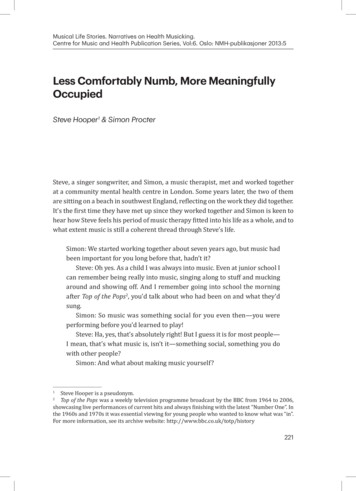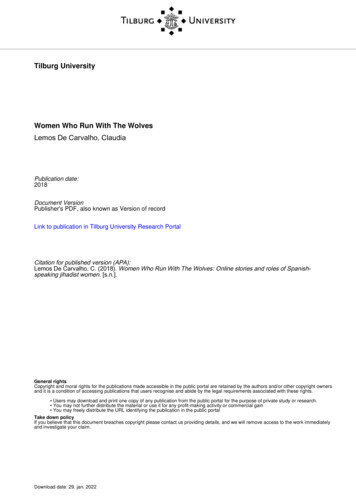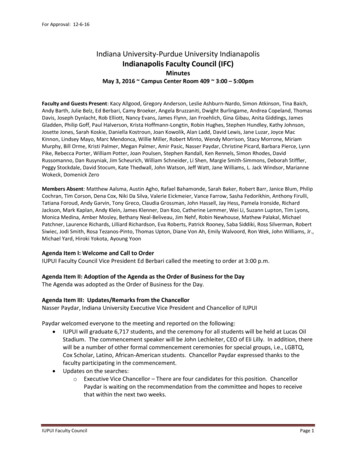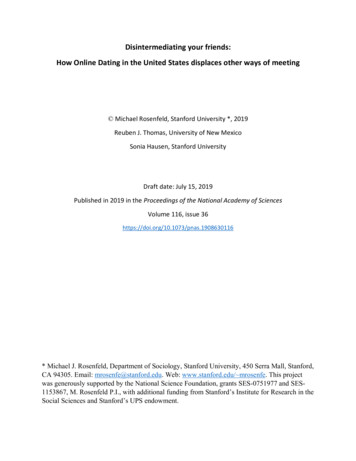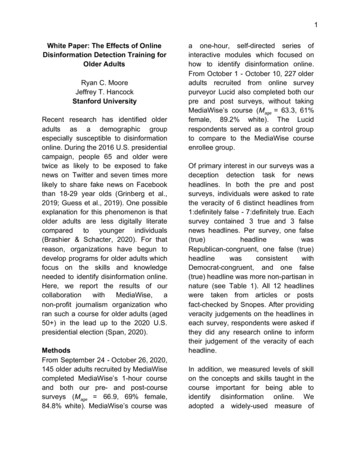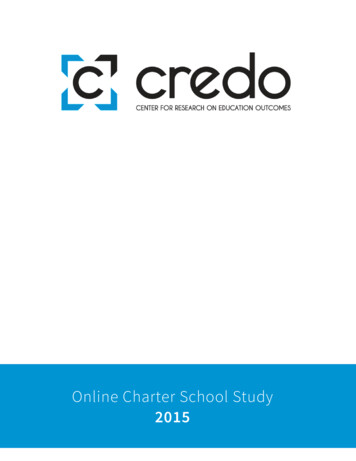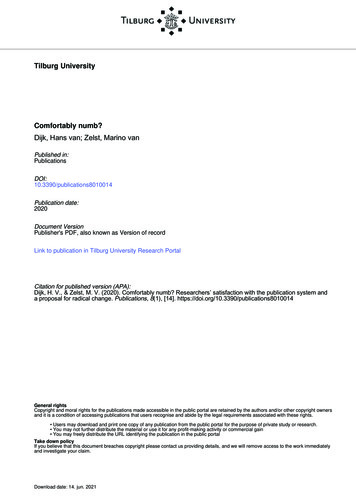
Transcription
Tilburg UniversityComfortably numb?Dijk, Hans van; Zelst, Marino vanPublished ication date:2020Document VersionPublisher's PDF, also known as Version of recordLink to publication in Tilburg University Research PortalCitation for published version (APA):Dijk, H. V., & Zelst, M. V. (2020). Comfortably numb? Researchers’ satisfaction with the publication system anda proposal for radical change. Publications, 8(1), [14]. https://doi.org/10.3390/publications8010014General rightsCopyright and moral rights for the publications made accessible in the public portal are retained by the authors and/or other copyright ownersand it is a condition of accessing publications that users recognise and abide by the legal requirements associated with these rights. Users may download and print one copy of any publication from the public portal for the purpose of private study or research. You may not further distribute the material or use it for any profit-making activity or commercial gain You may freely distribute the URL identifying the publication in the public portalTake down policyIf you believe that this document breaches copyright please contact us providing details, and we will remove access to the work immediatelyand investigate your claim.Download date: 14. jun. 2021
publicationsArticleComfortably Numb? Researchers’ Satisfaction withthe Publication System and a Proposal forRadical ChangeHans van Dijk *and Marino van ZelstTilburg University, Department of Organization Studies, 5037 AB Tilburg, The Netherlands; j.m.vanzelst@uvt.nl* Correspondence: j.vandijk1@uvt.nlReceived: 7 December 2019; Accepted: 25 February 2020; Published: 2 March 2020 Abstract: In this preregistered study we evaluate current attitudes towards, and experiences with,publishing research and propose an alternative system of publishing. Our main hypothesis is thatresearchers tend to become institutionalized, such that they are generally discontent with the currentpublication system, but that this dissatisfaction fades over time as they become tenured. A surveywas distributed to the first authors of papers published in four recent issues of top-15 Work andOrganizational Psychology (WOP) journals. Even among this positively biased sample, we foundthat the time it takes to publish a manuscript is negatively associated with whether authors perceivethis time to be justifiable and worthwhile relative to the amount their manuscript has changed.Review quality and tenure buffer the negative relationship with perceived justifiability, but notfor perceived worth. The findings suggest that untenured (WOP) researchers are dissatisfied withthe publishing times of academic journals, which adds to the pile of criticisms of the journal-basedpublication system. Since publishing times are inherent to the journal-based publication system, wesuggest that incremental improvements may not sufficiently address the problems associated withpublishing times. We therefore propose the adoption of a modular publication system to improve(WOP) publishing experiences.Keywords: meta–science; publication system; publishing times; satisfactionWhen I was a child I caught a fleeting glimpse,Out of the corner of my eye.I turned to look but it was gone.I cannot put my finger on it now.The child is grown, the dream is gone.I have become comfortably numb.Pink Floyd—Comfortably Numb1. IntroductionIn 2015 the hashtag #IAmAScientistBecause generated a massive response [1]. Researchers acrossthe globe shared the motivation behind their vocational choice. Two often heard responses revolvedaround the curiosity to understand and explain what is yet unknown, and to find solutions to problemsthat are yet unsolved. Such intrinsic motivations are known to be predictive of high levels of jobsatisfaction, commitment, and health [2].However, there are also numerous accounts of academics who gave up their jobs. Often-mentionedreasons are hypercompetition, perverse incentives in academia, and incremental science [3–5]—factorsPublications 2020, 8, 14; l/publications
Publications 2020, 8, 142 of 20that are known to hamper intrinsic motivation [6]. In this paper, we argue that these and relateddemotivating aspects of academia find their origin in the journal-based publication system. Sinceresearchers are evaluated mainly based on where and how much they publish, the publication systemis of primary importance to researchers’ job motivation and satisfaction [7].In the last decades, this publication system has come under strain: English has becomethe lingua franca of scholarly communication, causing an increasing number of institutions acrossthe globe to prioritize publications in English-language journals over publications in other languages.The corresponding increased scarcity of spots for publications in combination with the globalization ofthe academic job market has led to (a sense of) hypercompetition among academics [3]. In combinationwith several other, often mentioned design flaws in the publication system (e.g., long publishing times,flawed quality indicators based on which individual researchers are evaluated, biased reviews, seee.g., [8]), it stands to reason that the publication system is a prominent source of dissatisfaction amongresearchers. However, there is scant empirical research that has examined researchers’ satisfactionwith the publication system. Our first aim is therefore to fill that gap and delve deeper into researchers’perceptions of the publishing process.Specifically, in this study we focus on publishing time (defined as the time between papersubmission and acceptance for publication) as a major source of dissatisfaction with the publicationsystem. Publishing time is highly consequential for the careers of researchers (e.g., getting a timelyresponse can mean the difference between getting tenure or not), but out of their own control, whichmakes it a prominent source of stress and dissatisfaction [9]. Based on justice theory, which suggeststhat procedural and distributive justice shape outcome satisfaction [10], we specifically argue thatpublishing time negatively affects the extent to which researchers perceive publishing times to beworthwhile (as indicative of procedural justice, defined as the perceived fairness of outcomes [11]) andjustifiable (as indicative of procedural justice, i.e., the perceived fairness of the means used to determineoutcomes [10]). We also expect that these relationships are buffered by the quality of the reviews andthe impact factor of the journal1 in which a paper is published, respectively.Based on insights from system justification theory [12], we further hypothesize that researcherswithout tenure, in particular, are likely to become more dissatisfied when publishing time takes longer,in part because the outcomes are more important to the careers of researchers without tenure, andin part because researchers with tenure may have grown accustomed to long publishing times andderive their academic standing from the current publication system. We argue that the difference inexperiences between tenured and untenured academics is of pivotal importance, given that it suggeststhat those in charge of the publication system (e.g., editors) as well as those who trust in the publicationsystem for evaluating researchers (e.g., professors, deans) have grown numb to the problems withthe current publication system. As a consequence, they may fail to understand the reason, source, andgravity of untenured researchers’ dissatisfaction with the publication system. Moreover, it suggeststhat those in power to change the publication system are the ones who are less likely to do so becausethey are the ones who are comfortable within the system as it currently is [13].To go beyond the stage of merely identifying potential problems and instead proactively contributetowards a potential solution, the second aim of this paper is to conceptually envisage an alternative.As we consider prolonged publishing times to be a problem that is inherent to the journal-basedpublication system, we propose a radically different, holistic solution. For this, we build on the recentlyadvanced idea of a digital “research-as-you-go” publication system [14] to depict how we can movebeyond the journal-based publication system. Specifically, we propose a modular system [15] thatenables researchers to communicate their contributions immediately when they are ready. Such1We argue below that the journal impact factor (JIF) is a flawed measure of article quality. However, in our empiricalcontext, the JIF still represents a reliable measure of journal desirability, because it is still widely embedded in academia asa relevant measure of quality. The JIF is therefore likely to influence researchers’ satisfaction with a specific publication andthe corresponding publication process.
Publications 2020, 8, 143 of 20a system thus eliminates publishing times altogether and has various other advantages that we willoutline in the second, conceptual part of this paper.As such, our partly empirical and partly conceptual paper provides three main contributions tothe field. First, we contribute to the mounting evidence that researchers are dissatisfied with the currentpublication system. In focusing on publishing times, we build a theory and provide evidence regardingthe reasons for researchers’ dissatisfaction. Second, we address why, despite its problems and manycriticisms, the current journal-based publication system is so persistent by arguing and showingthat tenured researchers tend to be less dissatisfied with the current publication system compared tountenured researchers. Third, there has been very little reflection among Work and OrganizationalPsychology (WOP) researchers about cognitive alternatives for the current publication system [16].Rather than proposing some incremental changes, we envision what an alternative publication systemfor (WOP) research could look like.2. The Journal-Based Publication System: Paradise Lost?Scholars have argued that a publication system should serve five functions [17,18]. The first isregistration, which refers to the administration that a study has taken place and enables claimingprecedence of a scholarly contribution. In the current journal-based publishing system, this occurswhen a paper is published. Second, certification involves the process via which the contribution isvalidated. This typically occurs via peer review and editorial guidance. Third, awareness entailsthe ways in which scientific contributions are disseminated among stakeholders. In the last twodecades there has been a shift from dissemination via printed journals to the online dissemination ofarticles, but most research is still submitted to journals, after which it is printed and published by theirrespective publishers. Fourth, archiving indicates that a publication system should keep a record overtime of all scholarly contributions. Journals as well as repositories do this online, whereas librariesusually keep printed copies. Finally, the fifth function of a publication system is rewarding, whichprescribes that the system should generate metrics that can be used for evaluating and rewardingresearchers. Such metrics are predominantly journal-based (e.g., impact factor), but there is an increasein metrics at the individual researcher level (e.g., citations, h-index) as well as so-called altmetricswhich are on the article level (e.g., the amount of reads or the amount of mentions an article receives insocial media).In the pre-digital era, the journal-based publishing system was a relatively effective and optimalway to fulfill each of these five functions. Limitations in addressing a function were generally dueto external constraints (i.e., in time, space, and/or money). With the dawn of the digital era, manyof these constraints have—in theory—fallen away; in some ways the publication system is changingaccordingly, as is, for example, evidenced by the transition to the online dissemination and archivingof articles. However, in most other ways the publication system—in practice—has largely remainedthe same compared to the pre-digital age [19], which entails that many limitations are still in place.Examples of such limitations regarding the registration function of the journal-based publicationsystem include, for example, that the journal-based publishing system causes a bias in the scholarlycontributions that are registered [20] and only registers studies after they have been conducted andaccepted for publication—which can cause a delay of many years. To overcome publishing time,studies can be published before being reviewed (e.g., via preprint servers), but preprints are still notoften used and generally not considered as official academic output in the field of WOP.Whereas peer review is generally considered the best way for certification, the general limitof two-to-three reviewers and a single editor makes the current system prone to biases: whichreviewers are selected; the extent to which the reviewers and editor favor the topic and approach ofthe paper; the mood and experience of the reviewers and editor; the extent to which the judgment ofthe reviewers and editor is affected by style and grammar issues; etc. [21]. A potential solution can befound in enabling everyone to write a review, which is very common for most products and servicesnowadays [22], but still underused in academia.
Publications 2020, 8, 144 of 20With the vast majority of papers stored behind paywalls, there is still a major limitation inthe awareness and archiving functions of the current publication system that severely hampersdiscovery and innovation, and that exacerbates inequalities between those who have access and thosewho do not. Interestingly, even Harvard Library announced in 2012 that it could not afford to paythe subscr
Download date: 05. jun. 2021. publications Article Comfortably Numb? Researchers’ Satisfaction with the Publication System and a Proposal for Radical Change Hans van Dijk * and Marino van Zelst Tilburg University, Department of Organization Studies, 5037 AB Tilburg, The Netherlands; j.m.vanzelst@uvt.nl * Correspondence: j.vandijk1@uvt.nl Received: 7 December 2019; Accepted: 25 February 2020 .
